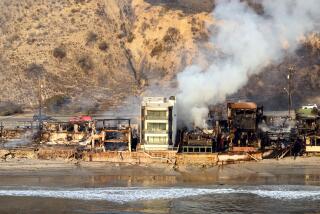Lifeguards Try for New Look in Towers : Beaches: A committee redesigns the wooden perches after a high-tech model intended to solve problems creates headaches of its own.
- Share via
For 13 years, John Baker’s office was the “House Tower” at Zuma Beach, a wooden lifeguard perch so named because a vintage bungalow once stood next to it.
Like most traditional lifeguard towers, the House Tower had flaws--the wood tended to rot, the shutters weren’t secure and graffiti was difficult to remove. But when the lookout was finally replaced with a state-of-the-art fiberglass tower, Baker had nothing but complaints.
“The ventilation was bad, it stunk inside and you didn’t have any privacy if you needed to change your clothes,” the veteran lifeguard said. He had a better view of the waves from the spaceship-like fiberglass shack, but he couldn’t help but feel that his old wooden perch was somehow, well, homier.
Baker wasn’t alone. In the six years since the Los Angeles County Department of Beaches and Harbors began replacing its old wooden lifeguard towers with high-tech fiberglass ones, the reaction from the county’s lifeguard corps has been an unwavering thumbs down.
“The chief complaint is that they’re cold and not homey, if you will,” said the county’s Chief Lifeguard Don Rohrer.
This summer, Rohrer challenged a committee of lifeguards to come up with a solution to the fiberglass-vs.-wood debate. The result, he said, has been the design of a wooden shack that combines the visibility of the $18,000 fiberglass tower with the natural feel of the cheaper wooden one.
“The design is out being engineered now, but we think we can bring it in for about $10,000,” Rohrer said. “We want to make the tower as comfortable as we can with the best visibility possible, and if we can do that and save half the price, it makes some sense, doesn’t it?”
About 35 of the county’s 170 towers have been replaced with fiberglass ones since 1985, when the first wave of 14 new fiberglass towers were stationed along the shoreline from Redondo Beach to Zuma Beach.
The idea, Rohrer said, was to replace every tower over a period of about 20 years as the wooden models gradually wore out, and to offer lifeguards a more efficient workstation than the existing ones.
“It costs a fortune to repair those things,” Rohrer said of the powder blue wooden shacks. “We have one painter who doesn’t do much more than remove graffiti from them year-round, and a couple of repairmen who don’t do much more than fix lifeguard towers.
“It’s a constant drain on the taxpayer’s dollar. And a tower sitting out on the edge of the beach at night is very vulnerable,” he said.
Last month, for instance, two couples were arrested in Hermosa Beach after police caught them holding an orgy in a lifeguard tower. Over the years, Rohrer added, “anything that can happened has happened” in the wooden lifeguard shacks.
“They’ve been blown up, burned down, people have been shot at from them. Homeless people sleep on the decks and if it’s raining they try to break in and sleep inside,” he said.
“Some, unfortunately, use the towers as restrooms and we have to come in with gallons and gallons of water to scrub them out.”
The fiberglass towers, Rohrer said, were designed to solve such problems. Their shutters are more secure, he said, and graffiti can be virtually wiped off their slick, fiberglass walls. Moreover, because the posts supporting their windows are very narrow, the view of the ocean is much more complete than from a wooden tower.
But those advantages carry with them a whole new set of problems, veteran lifeguards say.
The mechanism on the shutters is so complex that it sometimes takes two lifeguards just to lock one tower. The graffiti-resistant fiberglass smells, well, like fiberglass and lifeguards detest the chemical odor.
The big, outward-leaning windows give the fiberglass shacks the feel of public fishbowls; lifeguards complain that they can’t even change into dry clothes anymore without giving thousands of beach-goers a free show.
And, adding to the drawbacks, the Northridge firm that manufactured most of the county’s fiberglass shacks filed for bankruptcy last month, Rohrer said.
“Finally, we all just kind of said, ‘What was wrong with the good old wooden towers?’ ” explained Val Jolley, a 15-year Torrance lifeguard whom Rohrer appointed to the committee.
Jolley, who went from full-time to part-time lifeguarding in 1986 to run a contracting business, used his construction expertise to help Baker and the rest of the committee design a wooden structure that featured expansive views and better security without the sterile, pungent atmosphere of the fiberglass models.
Although the details are still being worked out, he said, the new wooden design should be available as an option by the time the county decides to install its next round of replacement shacks. (Because of the county’s budget difficulties, Rohrer said, no specific time line has been set for the next round of replacements.)
Meanwhile, Baker said, the lifeguards are grateful for the opportunity to preserve a tradition of sorts.
“You work in a tower five days a week for years at a time, it becomes like a second home to you,” he said. “You paint it. You take care of it. It’s your office. And you can get real attached to it.”
More to Read
Sign up for The Wild
We’ll help you find the best places to hike, bike and run, as well as the perfect silent spots for meditation and yoga.
You may occasionally receive promotional content from the Los Angeles Times.






